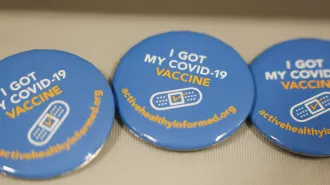Screen addiction affects teens’ mental health. How to spot it, and help
Parents and caregivers should focus on how teens use screens rather than just how much

Screen addiction rather than the amount of screen time can predict mental health problems in teens, a new study shows. Screens are everywhere, though, so treating such addiction is challenging.
Anastasiia Sienotova/Getty Images
School’s out. Teens are bored. And the siren call of social media and video games beckons.
Parents and caregivers bungling through new summer routines, or lack thereof, have long sought to balance the time kids spend glued to screens with time spent outdoors. Many worry about the increasing evidence linking teen screen use to skyrocketing mental health problems.
But finding that balance might not be key to warding off teen anxiety, depression, aggression and suicidal thinking, researchers report in June in the Journal of the American Medical Association. That’s because screen addiction — not just the amount of screen time — appears to predict the onset of such problems. Signs of addiction include compulsive use, difficulty disengaging and distress when not using screens or devices. Out of over 4,000 children surveyed, about 30 percent were showing signs of addiction to social media and 40 percent to video games by age 11, data scientist and mental health expert Yunyu Xiao and her team report June 18 in JAMA.
“If parents or teachers just come in and say, ‘No you cannot use [screens],’ that may not actually address the problem,” says Xiao, of Weill Cornell Medical College in New York City.
Addressing this form of addiction is challenging given screens’ ubiquity. Teens, or anyone for that matter, cannot just quit screens as they might quit other problematic behaviors, such as excessive drinking or gambling. Science News spoke with several experts studying screen use in teens to help families navigate this complex issue.
What are markers of problematic screen use in teens?
To date, most studies have measured screen time as a proxy for problematic screen use in teens, experts say. And teens’ screen time, which had been steadily ticking upward prior to the pandemic, seems to have shot up during the public health crisis, according to a 2021 report by nonprofit digital safety and research organization Common Sense Media. Among 13- to 18-year-olds, average time on screens increased from roughly 7.2 hours per day in 2019 to roughly 8.4 hours per day in 2021.
But most research treats screen-based activities as a monolith, write psychologist Annie Maheux and colleagues in March in the Annals of the New York Academy of Sciences. For instance, like many other polls and studies, the Common Sense report’s definition of screen time summed up all digital activities, including time on social media, reading online, playing video games and browsing websites.
When it comes to mental health, researchers have long suspected that how kids use screens might matter more than how much. But scientists have lacked the long-term data needed to address the issue, says Maheux, of the University of North Carolina at Chapel Hill. “We want to have early enough data so we can ask the question of what comes first, the phones or the vulnerability [to problematic use]?”
The research remains preliminary but is maturing. In 2015, the U.S. Adolescent Brain Cognitive Development study enrolled nearly 12,000 children ages 9 and 10. Every year since, participants and their caregivers have filled out surveys, including ones on screen time, types of screen use, feelings around screen use and mental health.
For the JAMA study, Xiao and colleagues analyzed survey responses from nearly 4,300 children who had completed follow-up surveys at years 2, 3 and 4 between 2015 and 2023. They found that addiction patterns varied by screen activity. Video games showed the clearest addiction patterns. Some 40 percent of children showed signs of addiction at age 11 and stayed hooked a couple years later. The remaining children never seemed to get hooked.
The smartphone and social media data are harder to parse as some of the observed rise in addiction could be explained by children gaining access to those devices and platforms as they got older. But a large percentage of children — up to half — seemed to show signs of addiction or increasing addiction by the last year of data collection.
Signs of screen addiction
Between 2015 to 2023, researchers repeatedly surveyed over 4,000 tweens to teens to see if, and when, they began struggling with social media, video game or smartphone addiction — including compulsive use or distress when not on screens. Responses ranged from “never” to “very often” or “strongly agree.” The surveys, part of the long-running Adolescent Brain Cognitive Development, or ABCD, study, showed that addiction patterns varied by screen type. Sample questions included:
- I spend a lot of time thinking about social media apps or planning my use of social media apps.
- I feel the need to use social media apps more and more.
- Arguments have arisen with others because of my phone use.
- I have been unable to reduce my phone use.
- I lose track of how much I am using my phone.
- I play video games so I can forget about my problems.
- I’ve become stressed or upset if I am not allowed to play video games.
Overall, kids showing signs of addiction reported a greater likelihood of suicidal thinking, depression, anxiety, aggression and rule-breaking behaviors than their peers. The findings were gendered with more girls getting hooked on social media and more boys getting hooked on video games. Being Black or Hispanic and lower-income also increased the risk of addiction. Xiao hopes this sort of work will help clinicians identify at-risk children early on.
“Just like some people are more susceptible to alcoholism or addictive substance use, I do think some kids have predispositions to addiction to screens,” says pediatrician Jason Nagata of the University of California, San Francisco, who cowrote an editorial accompanying the JAMA study.
What makes teens vulnerable to screen addiction?
As teens transition from childhood to adulthood, it’s developmentally appropriate for them to take more risks, seek validation from peers and find partners. But the adolescent brain, particularly the prefrontal cortex — which puts the brakes on the brain’s dopamine-releasing reward center — doesn’t fully develop until age 25 or so, says psychiatrist and addiction medicine expert Anna Lembke of Stanford University.
Enter social media. Endless feeds with options to tag photos, like content and comment deliver constant small rewards, or bursts of dopamine, researchers wrote in January in Cureus. Those continuous mini rewards overactivate the dopamine system, leading to a decline in pleasure over time, a hallmark of addiction.
While adults can also get hooked on social media, teens’ faulty brakes make them more vulnerable to such platforms, says Brad Zicherman, a child and adolescent addiction psychiatrist also at Stanford, who was not involved with that review. He likens the allure of social media to that of slot machines.
“You pull the slot machine lever. You don’t know what you’re going to win. You don’t know when you’re going to win. Eventually you do win something. And then you do it again,” Zicherman says. “You keep getting those rushes of dopamine the entire time. That’s exactly how social media works.”
What can parents and caregivers do?
With substance use or gambling disorders, many sufferers know that a single hit, drink or visit to the casino can trigger a downward spiral. So abstaining from such behaviors is often the goal. But even if that logic holds true for teens addicted to screens, abstention is impossible, Lembke says. “We can get alcohol out of the house. It’s very hard to go off the grid. You have to basically opt out of modern society.”
Instead, Lembke suggests thinking about screen use like ultraprocessed foods. People often create rules around eating such foods, such as no potato chips for breakfast or indulging in dessert only on special occasions, Lembke says. Similarly, adults in children’s lives need to create stringent rules around screen use. “You have to treat it like cake,” she says.
Just as too much cake can make someone too full to eat other foods, excessive screen use can steal time from other activities, notes the American Academy of Pediatrics. Rather than focusing solely on reducing screen time, the AAP advises families to think about which activities, such as getting outside, are being crowded out by screen use. The AAP and other experts also recommend creating screen-free zones in the home, particularly the dinner table and bedroom, and having parents and caregivers model appropriate screen etiquette.
Sometimes, though, a more drastic opt-out may be needed. For example, Zicherman advises parents in his addiction treatment clinic to take away their kids’ phones for several weeks. “Things are going to get worse before they get better,” Zicherman cautions. That’s because when teens first lose access to the device they’ve gotten hooked on they are likely to act out, rebel or shut down — what Zicherman calls an “extinction burst.” But kids eventually rebound and find other activities, Zicherman has found.
While teens struggle to manage their social media and smartphone use, many researchers note that digital technologies also help teens remain connected with each other. Zicherman, however, now thinks that the cons of such platforms and devices outweigh any benefits. For parents thinking about getting their teen a phone, he is unequivocal: “Get them a dumb phone.”
What broader solutions are needed?
Absent societal changes, families face an uphill battle, experts acknowledge. “Many of the features that drive problematic use are not accidental. They are core to the business models of these platforms,” says Amber van der Wal, a youth and media researcher at the University of Amsterdam.
She and others say that policy makers must hold companies accountable. In the United States, many states have passed or are considering legislation to protect kids from social media companies. Last year, California passed a bill making it illegal for companies to feed addictive content to minors. The law also bars app producers from sending notifications to minors during times that coincide with school or sleep. Whether these patchwork efforts will adequately protect children remains to be seen.
Researchers say other sectors must also step up. While online gaming is now a formally recognized form of addiction, the same cannot be said for other forms of screen addiction. “Social media has become the dominant factor in the lives of teenagers,” Zicherman says. “[Yet] many great child and adolescent psychiatrists don’t even ask about social media use.”
Schools similarly need to talk more about how, or if, to integrate devices, such as Chromebooks, into the classroom, Lembke says. “Your kid can get addicted to digital media at school even if they don’t have access at home.”
Yet Lembke remains hopeful about the future. Look at the growing national discussion around getting smartphones out of schools, she says. “I was talking about getting smartphones out of high schools and younger [grades] 15 years ago. People thought I was crazy…. Now we have lots of schools experimenting with a phone-free day.”







